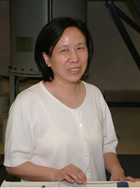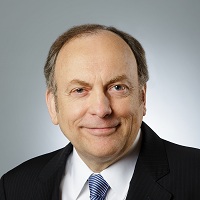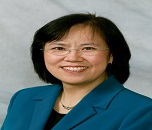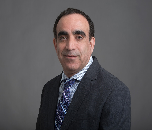Day 2 :
Keynote Forum
Diana Anderson
University of Bradford, UK
Keynote: An empirical assay for assessing genomic sensitivity and for improving cancer diagnostics
Time : 08:30-08:55

Biography:
Diana Anderson holds the Established Chair in Biomedical Sciences at the University of Bradford. Her first degree is from the University of Wales and second degrees from the Faculty of Medicine, University of Manchester. She has 450+ peer-reviewed papers, 9 books, has successfully supervised 28 PhDs. She is currently supervising 6 more and is/has been a Member of Editorial Boards of 10 international journals. She is Editor in Chief of a Book Series on Toxicology for the Royal Society of Chemistry. She gives key note addresses at international meetings and is a Consultant for international organisations (WHO, NATO, TWAS, UNIDO, OECD). Her H index=54.
Abstract:
Detection tests have been developed for many cancers, but there is no single test to identify cancer in general. We have developed such an assay. In this modified patented Comet assay, we investigated peripheral lymphocytes of 208 individuals: 20 melanoma, 34 colon cancer, 4 lung cancer patients 18 suspect melanoma, 28 polyposis, 10 COPD patients and 94 healthy volunteers. The natural logarithm of the Olive tail moment was plotted for exposure to UVA through different agar depths for each of the above groups and analysed using a repeated measures regression model. Response patterns for cancer patients formed a plateau after treating with UVA where intensity varied with different agar depths. In comparison, response patterns for healthy individuals returned towards control values and for pre/suspected cancers were intermediate with less of a plateau. All cancers tested exhibited comparable responses. Analyses of Receiver Operating Characteristic curves, of mean log Olive tail moments, for all cancers plus pre/suspected-cancer versus controls gave a value for the area under the curve of 0.87; for cancer versus pre/suspected-cancer plus controls the value was 0.89; and for cancer alone versus controls alone (excluding pre/suspected-cancer), the value was 0.93. By varying the threshold for test positivity, its sensitivity or specificity can approach 100% whilst maintaining acceptable complementary measures. Evidence presented indicates that this modified assay shows promise as both a stand-alone test and as a possible adjunct to other investigative procedures, as part of detection programmes for a range of cancers.
Keynote Forum
Xiaolian Gao
University of Houston, USA
Keynote: How pancreatic cancer cell signaling proteins (CSPs) respond to tyrosine kinase inkibitor (TKIs) therapeutics- Peptide microarray, peparrayTM is a powerful molecular tool for CSP profiling
Time : 08:55-09:20

Biography:
Xiaolian Gao has expertise in Chemistry and Biotechnology Development, specifically technologies for massively parallel synthesis of peptides and oligonucleotides on microarray/biochip surfaces. Her team has since developed genomic and proteomic applications to analyze complex biological samples to address questions of biological functions of microRNA and long noncoding RNAs, enzymatic proteins and post-translational modified (PTM) proteins. The biochip technology has led to the establishment of platform of high throughput production of biomolecules and multiplex assay of biomolecules and their interactions.
Abstract:
It is well accepted that molecular profiling of cellular proteins or nucleic acids can offer answers to causes of diseases and underlined connections of pathogenic molecules, and thus, pointing out therapeutic targets. However, protein profiling, especially at the cellular level has been challenging. There is only limited choices to allow systematic investigation of cellular protein activities, such as their responses, (i.e., sensitive, or nonresponsive or resistant, to therapeutic treatment). This presentation reports peptide microarray chip (PeparrayTM) technology developed as a powerful molecular tool for proteomic profiling of Cellular Signaling Proteins (CSPs) to interrogate CSP variations in cancer cells induced by treatment of a new generation of anti-cancer therapies, i.e., tyrosine kinase therapeutics (TKIs). Peparray chips encode a large number of receptor kinase protein (RTK) phosphotyrosine (pY) motif peptides. These are probes for capturing of phosphotyrosine binding domain proteins (PPBD), the profiling thus reveal signaling network activities, which can be translated into clinic relevant information valuable for therapeutic treatments. The case studies involving cellular protein profiling of pancreatic cancer treated with three generations of small molecule tyrosine kinase (EGFR) inhibitors (TKis): Erlotinib (TarcevaTM); Afatinib (Gilotrif TM); and the 2016 FDA approved AZD9291 (TagrissoTM). Peparray™ studies revealed molecular signature profiles of cellular conditions through proteins of commonly or differentially expressed. These proteomic profiles revealed 80 signaling proteins with Erlotinib treatment and 135 signaling proteins with Afatinib treatment and 78 signaling proteins with AZD9291 treatment. The detected signaling proteins are implicated in 38-39 cancer related KEGG pathways. Such information about functional cellular proteins provided valuable molecular signature, which reflect cancer status to allow assessment of effectiveness of cancer treatment, i.e., sensitive vs. insensitive, responsive vs. resistant. Our analysis further revealed signaling pathways responsible for therapeutic resistance. Peparray proteomic and signaling pathway results thus hold clinical significance in identifying molecular markers in therapeutic treatment of cancers, and in cancer therapeutic strategy decision making. These results call for population applications for monitoring and predicting of therapeutic effectiveness, for wide spread expansion of molecular medicine as basis of precision medicine to greatly benefit human health and wellness.
Keynote Forum
Colleen Huber
Naturopathic Oncology Research Institute, USA
Keynote: Vitamin C and cell signaling in cancer
Time : 09:20-09:45

Biography:
Colleen Huber is a Naturopathic Medical Doctor in Tempe, Arizona. She was the Keynote Speaker at the 2015 Euro Cancer Summit, the 2016 World Congress on Cancer Therapy, and a Keynote Speaker at the 2016 World Congress on Breast Cancer. She is President of the Naturopathic Cancer Society. She is a Naturopathic Oncologist and Fellow of the Naturopathic Oncology Research Institute. She authored the largest and longest study in medical history on sugar intake in cancer patients, which was reported in media around the world in 2014.
Abstract:
Research has shown that cytokines such as interferon and interleukin, secreted by the immune system, have an inflammatory effect and play an important role in tumor angiogenesis. High dose intravenous Vitamin C (HDIVC) counteracts this. Vitamin C taken orally cannot attain sufficiently high concentrations in the bloodstream to kill cancer cells. However, intravenous use of ascorbic acid has been shown to rise to concentrations that have killed cancer cells in vivo and in vitro. Vitamin C has been shown to form collagen and to inhibit hyaluronidase leading to stronger membrane integrity and tensile strength of normal tissue, which inhibits invasion and thus metastases. Cancer patients were given HDIVC as part of a naturopathic treatment protocol in an out-patient clinical setting. Data are reported for all patients. Many patients voluntarily left our practice, against our advice, primarily for financial reasons, while still having cancer. Of the remaining patients, 175 either went into remission confirmed by imaging. 44 died while still our patients. Of the 175 who went into remission, 12 had chosen chemotherapy also while having our treatments. Stages 1, 2, 3 and early stage 4 patients at start of treatment had much better outcomes than late stage 4 patients in general. The 32 patients who complied with our dietary and treatment protocol, and still did not survive their cancers must be seen as an 8% failure rate if considered of all 379 patients, or a 15% failure rate if taken of the 210 patients who stayed to complete our treatments.
Keynote Forum
Michael D West
BioTime Inc., USA
Keynote: The use of pluripotency in the manufacture of advanced cell-based tissue-engeneered therapeutics
Time : 09:45-10:10

Biography:
Michael D West is the Chief Executive Officer of BioTime, Inc. (NYSE-MKT: BTX) and its subsidiary AgeX Therapeutics. The companies are focused on developing therapeutic products using human embryonic stem cells. He received his PhD from Baylor College of Medicine and has focused his academic and business career on the application of developmental biology to the age-related degenerative disease. He was previously the Founder of Geron Corporation (NASDAQ: GERN), where he initiated and managed programs in telomere biology and human embryonic stems and later CEO at ACT (Ocata) (NASDAQ: OCAT) managing programs in somatic cell nuclear transfer and cell-based retinal therapeutics.
Abstract:
Human pluripotent stem cell lines display the potential to cascade through all primary germ layers and hence, almost certainly, all human somatic cell types. This pluripotency has led to the prospect of using master cell banks of pluripotent cells to generate previously rare and valuable cell types on an industrial scale. The growing need for precise genetic modifications in cell-based therapeutics (such as in applications in immunotherapy) highlights the unique advantage of pluripotency in facilitating repeated targeting events in the master cell banks followed by immortal propagation and subsequent differentiation of differentiated cell types. The demonstration that downstream embryonic progenitors can be robustly expanded clonally is leading to improved manufacturing technologies with enhanced definition of purity and identity. The maintenance of a regenerative phenotype in pluripotent stem cell-derived products as evidenced by a lack of markers of the embryonic-fetal transition (EFT), suggests these cells may have the potential to participate in scarless tissue regeneration. Lastly, the use of defined matrices to facilitate differentiation in vitro or to facilitate engraftment in vivo, provide a broad technology platform that will potentially impact numerous fields of medicine. We will provide an update on ongoing clinical trials as well as products in preclinical development.
Keynote Forum
Xiuzhi Susan Sun
Kansas State University, USA
Keynote: Advanced biomaterial PepGel - a new tool for translational research in cell therapy
Time : 10:10-10:35

Biography:
Xiuzhi Susan Sun is a distinguished Professor of Kansas State University. She is the Founder of the Biomaterials and Technology Lab at KSU. Her research interests are in biomaterials design and fabrication, particularly in protein and lipids structure and functional properties at monomers and polymer levels for environmental and medical applications, such as hydrogels, biobased adhesives, resins and coatings. She is a key Founder of the PepGel and PG Biotech companies with the purpose of improving human health through her novel biomaterial discoveries. She earned her Doctor of Philosophy from the University of Illinois Urbana-Champaign, IL.
Abstract:
Life science and biomedical advancement have been limited by the traditional 2D cell culture system. Industries and scientists are switching to 3D cell culture system with the hope of more accurately mimicking the native extracellular microenvironment for translational research leading to clinical applications. Advanced self-assembly peptide hydrogel (PepGel) technology has been recently developed in the Biomaterials and Technology Lab at Kansas State University. The peptide structure was inspired by human muscle and spider silk backbone structure that can form hydrogels at physiological conditions. The peptide can self-assemble into nanofiber networks with 5-150 nm in diameter and 50-2000 nm in pore size that are similar geometry to extracellular matrix (ECM). The hydrogel has sheer-thinning and self-healing properties. This new PepGel system has large flexibility in controlling the gel stiffness, viscoelastic behavior, and surface properties. ECM ligands can be rationally built in the backbone of the PepGel to improve cell properties as needed. PepGel is injectable and biocompatible to biological system as well as compatible with many ECM proteins and cell growth factors. Because of this, the PepGel may have multi applications in the advancement of cell therapeutics strategies for various difficult diseases. This seminar will present PepGel technology, cell studies in vitro and cell delivery in vivo, and case studies with stem cells , cancer cells, virus/antigen, and 3D cell based model for drug toxicity testing.
Keynote Forum
Magnus S Magnusson
University of Iceland, Iceland
Keynote: T-patterns in human and neuronal interactions and on DNA: Spatio-temporal self-similarity and translation symmetry
Time : 10:35-10:55

Biography:
Magnus S Magnusson, PhD, Research Professor, created the T-pattern model with detection algorithms and special purpose software (THEMETM, PatternVision). He Co-directed a two-year DNA analysis project, published numerous papers and invited talks and keynotes at international conferences and at leading universities in Europe, Japan and the US within Ethology, Science of Religion, Mathematical Sciences, Neuroscience, Bioinformatics, Genetics, Proteomics and Mass Spectroscopy. He served as Deputy Director 1983-1988 in the Museum of Mankind of the National Museum of Natural History, Paris. From 1988 to 1993, he served as invited Professor at the University of Paris (V, VIII & XIII) in Psychology and Ethology (Biology of Behavior). Since 1991, he is the Founder and Director of the Human Behavior Laboratory, University of Iceland, leading a formalized network of 24 universities initiated at the University of Paris V, Sorbonne, Paris, in 1995 based on “Magnusson’s analytical model”.
Abstract:
How do cells organize their interactions in time? As a candidate for the search for answers, this talk considers a particular pattern type, called T-pattern. Originally proposed and developed for ethological analysis of human interaction, it has more recently also been applied to dynamic signaling between cells in neuronal networks in brains. The T-pattern is a self-similar hierarchical structure on a single dimension, in time or space, and can be seen as a particular recurrent statistical pseudo-fractal object characterized by statistically significant translation symmetry over all its instances. Just two occurrences may allow detection. A number of extensions to the T-pattern have been defined together constituting the T-System, all of which can be detected using the especially developed THEMETM software widely applied to interaction analysis of organisms from neurons to humans, while DNA and protein analyses are in progress. Examples of T-patterns detected in human interactions and within neuronal networks are presented. The T-pattern structure of genes in DNA and, consequently, in proteins, suggests self-similar spatio-temporal structure across wide spans of temporal and spatial scales, from nano, to neuronal, to human. The self-similarity extends to broader aspects of intra- and inter-cellular interactions as the organization of the biologically recent human mass-societies seem to reflect important aspects of social organization in Cell City as will also be exemplified.
Keynote Forum
Sasha Shafikhani
Rush University Medical Center, USA
Keynote: Discovery of apoptotic compensatory proliferation signaling and its implication in tumor biology and cancer therapy
Time : 11:10-11:35

Biography:
Sasha Shafikhani is an Associate Professor in the Department of Medicine, Division of Hematology, Oncology, and Cell therapy at Rush University Medical Center. His group is interested in understanding how the presence of tumor and infection lead to a state of immune-confusion affecting both anti-tumor and anti-bacterial immune defenses. His group is also interested in developing bacterial toxins as effective anti-cancer therapeutics. His group is also interested in innate immune disregulation that renders diabetic wounds vulnerable to infection.
Abstract:
Apoptosis, in addition to its role in programmed cell death (PCD), has also been implicated in triggering Compensatory Proliferation Signaling (CPS) -- whereby dying cells induce proliferation in neighboring cells as a means to restore homeostasis. To date, the molecular components, the nature of signaling, and the underlying mechanism of CPS remain largely unknown. Recently, we demonstrated that Pseudomonas aeruginosa Exotoxin T (ExoT) induces potent apoptosis in a variety of highly metastatic and resistant tumor cells in vitro and in vivo. We demonstrated that ExoT induces two distinct forms of apoptosis. Through its GTPase Activating Protein (GAP) domain activity, it induces caspase-9-dependent intrinsic apoptosis, while through its ADP-ribosyl transferase (ADPRT) domain, it disrupts integrin survival, causing anoikis apoptosis. During these studies, we have discovered that a fraction of apoptotic cells generate and release CrkI-containing microvesicles, in vitro and in vivo, which are capable of inducing compensatory proliferation in neighboring cancer cells upon contact by activating JNK. For the first time, we provide visual evidence of CPS and show by live videomicroscopy how CrkI-containing microvesicles are generated and how they induce proliferation in other cancer cells upon contact. Our Scanning Electron Microscopic (SEM) and Differential Interference Contrast (DIC) imaging as well as our proteomics and biochemical data indicate that ACPSVs are distinct from apoptotic bodies and exosomes. We further provide evidence that inactivating CrkI by ExoT or by mutagenesis blocks vesicle formation and inhibits CPS in apoptotic cells, thus uncoupling CPS from apoptosis. Given that majority of existing cancer cytotoxic therapeutics destroy tumor cells by apoptosis, CPS could significantly limit their effectiveness, contributing to the disappointing outcomes associated with therapeutic agents against cancer. Understanding the mechanism of CPS could lead to the development of novel targeted therapies that improve the effectiveness of current cancer therapies by inhibiting CPS.
